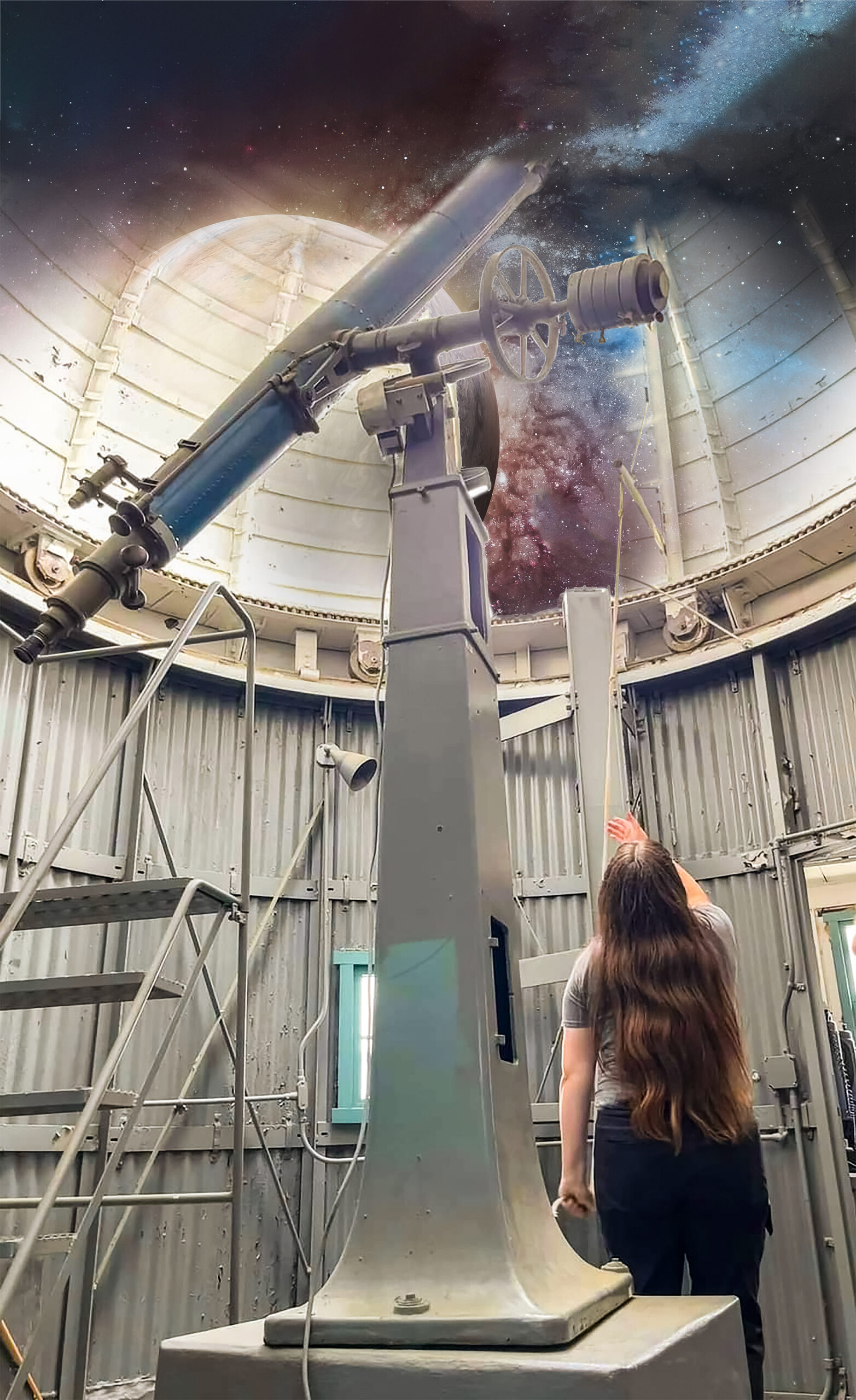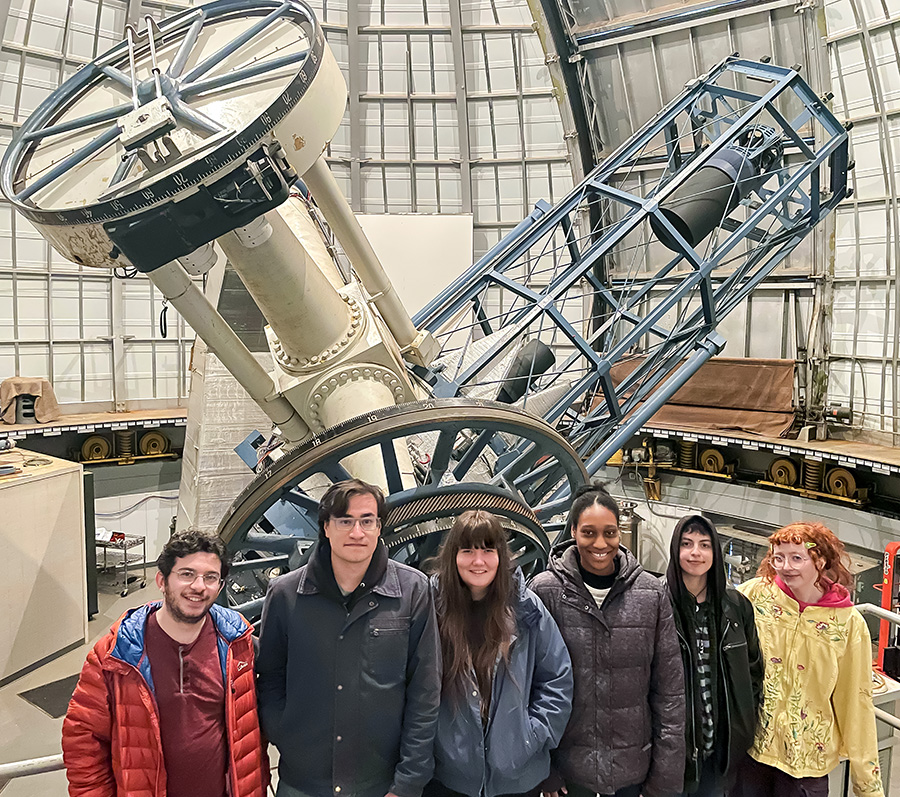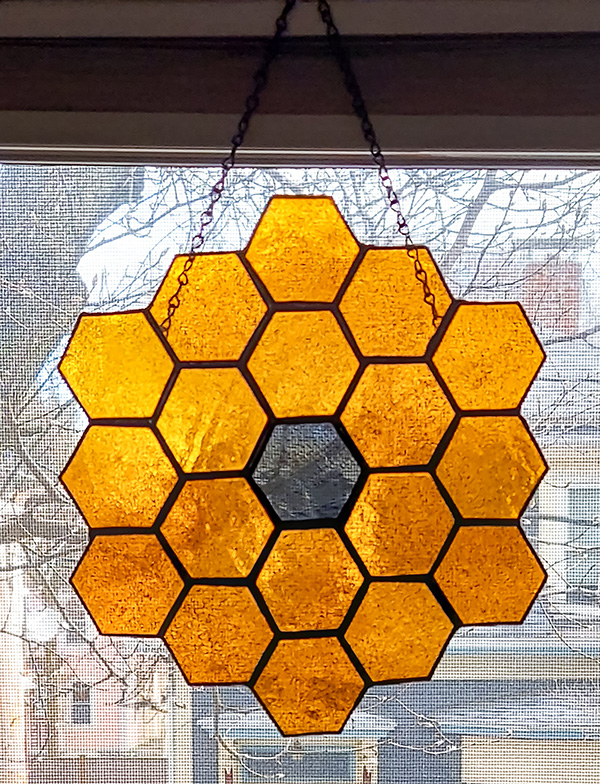

In the swirling upper atmosphere of Jupiter, temperatures soar to a scorching 1,000 degrees Fahrenheit—far hotter than scientific models predict. The discrepancy has puzzled and troubled scientists for decades and may hold critical clues for Earth’s climate crisis and humanity’s search for a second home among the stars.
Here on Earth, Kate Roberts ’22, a Ph.D. student at Boston University, is hard at work examining ground-based telescope observations of Jupiter and creating temperature maps to help solve what is known as the Giant Planet Energy Crisis.
“I enjoy the problem-solving aspect of research, and that’s a lot of what I’m doing on a day-to-day basis,” Roberts said. “I know what my end result should be and essentially what path I need to take, but the exact steps I take on that path aren’t always clear. I have to figure a lot out and backtrack and maybe redo something a little bit better later on.”
Along the way, Roberts, whose pronouns are they/them, leans on lessons learned as a deeply liberal arts double major at Kalamazoo College, with the scientific knowledge and complex thinking they gleaned from physics and the creativity they developed in studio art.
“The wider research field has models of the upper atmospheres of all of the giant planets—Jupiter, Saturn, Neptune, Uranus—and for a very long time, the models have under-predicted how hot the planets should be,” Roberts said. “That under-predicting is not a good thing, because that means we have a bunch of energy that we don’t know where it’s coming from. The goal of my research is to try and narrow down where all this extra energy is coming from. You would think we would know by now, but it’s been a running question in the field for about 50 years.”
Why does it matter? As we grapple with the future of our own warming planet, Roberts said, developing a broader understanding of how atmosphere and temperature function and develop on different planets could make or break our ability to predict and manage the course of climate change.
“By observing Jupiter and the other planets, we expand our repertoire in terms of understanding the upper atmospheres of other planets,” Roberts said. “If we look at a planet like Mars, we imagine that we can think back to a time where Mars may have been habitable and may have had a thick atmosphere where something could survive there. We look at Mars in the present day, and it has a very thin atmosphere, and as temperatures get higher and higher in the upper atmosphere, molecules that are in the atmosphere have a higher velocity, and they can escape the planet’s gravity entirely.”
The more scientists understand the factors that can power those higher temperatures—especially on a planet like Jupiter, that defies what we think we know—the better chance we have to keep Earth habitable.
“It’s unclear how significantly climate change is currently affecting our upper atmosphere, and it’s likely that there are other things at play that could change in the future, but things that could become more important on Earth may be present on Jupiter currently,” Roberts said. “Understanding upper atmospheres as a whole will help us understand Earth. It’s a small piece to a larger puzzle, and we hope to contribute to that puzzle of habitability.”
Grasping what happens in a planet’s atmosphere and why also aids in assessing planets outside our solar system.
“There is a big search in the field for exoplanets, or planets around other stars,” Roberts said. “The hope is to find another planet we could live on.”
Why is Jupiter so hot?
For a long time, Roberts said, we couldn’t even pinpoint the average temperature in Jupiter’s upper atmosphere. Their research has shown that it’s around 800 Kelvin, which is 530 Celsius, or 980 Fahrenheit.
There are theories, of course, around the high temperatures. Roberts is considering two of them, which are likely both present, to assess whether one is dominant and how they both might play out.
One theory involves heating by the planet’s auroras.
“The region where the aurora is present is much hotter than everywhere else on the planet,” Roberts said. “It makes sense to think that the heat at the poles could escape and go toward the equator, but Jupiter rotates much faster than Earth, and Coriolis forces due to the rotation should hold that heat in place.”
The second theory focuses on an internal source of energy.
“Energy could get to such high regions in the atmosphere through waves that emanate from the middle of the planet,” Roberts said. “We’ve observed similar wave heating on Earth. If you have, say, wind passing over a mountain, you can see the effect of that change in wind direction emanate all the way into the upper atmosphere. Those waves can have an overall heating effect, but we don’t know how significant that heating could be, especially on a planet like Jupiter, where pretty much the entire thing is gas. There’s no real surface to the planet, so the waves must be created in a different way. We do see a lot of turbulence in the planet. In a high-quality image of Jupiter, you see that it has a lot of modeling and interesting textures and swirling and patterns on what we view as the surface. We know there are interactions, but we don’t know exactly what the result of them is.”
Here’s where the creativity and the working backward come in: Roberts is creating high-resolution temperature maps of the planet. If the auroras cause the heat, they expect to see smooth gradients of hot to cold moving from the auroras to the equator. If wave heating is present, the maps should show spots of heat.
So far, the maps seem to show auroral heating, although more research could show sporadic wave heating that has not yet coincided with observation data. Auroral heating begs the next question: How is the heat escaping the poles?

Collaboration with scientists who build models to tackle that question could be in Roberts’ future. They also are planning future research to dig deeper into temperatures on Jupiter’s Great Red Spot and to broaden data comparisons over the whole planet. Their next steps aren’t set in stone, but whatever direction they head, the research will be supported by a Future Investigators in NASA Earth and Space Science and Technology (FINESST) grant Roberts won in 2023. FINESST awards are research grants for up to three years and up to $50K per year for graduate student-designed and performed research projects that contribute to the Science Mission Directorate’s science, technology and exploration goals.

The grant pays Roberts’ stipend, allowing them to focus on research and easing the way for their advisor, Luke Moore, research assistant professor of astronomy. It also affords them a travel budget for conferences, which they have used for a conference in San Antonio and a science meeting in Bern, Switzerland, for scientists engaged in related Jupiter research.
While the grant is a boon for Roberts now and in the near future, they have a broader perspective on the graduate student experience and have been on strike in solidarity with Boston University’s graduate workers’ union fighting for a living wage, child care subsidies, improved health care and increased stipends.
Roberts also continues to balance science with art. At K, they focused on ceramics. With more constraints on time, space and resources now, they recently started making stained glass. Roberts has created items including a lampshade with a series of birds, a piece inspired by the gold hexagonal mirror on the James Webb Space Telescope, and a glass panel with Jupiter in the middle.
“It’s another thing to do to keep me busy that isn’t too science-y,” Roberts said. “It’s good to be able to balance analytical, complex math with thinking creatively and working into new realms.”
